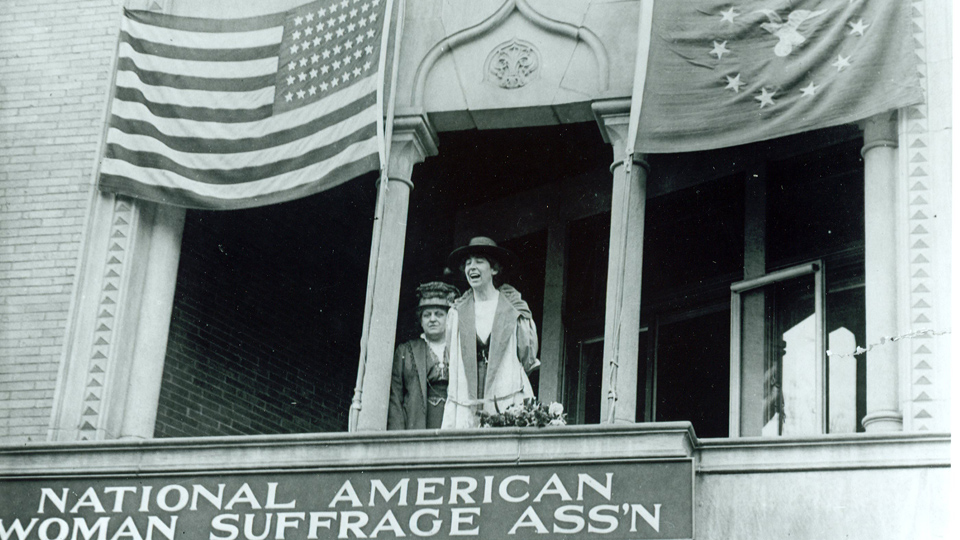
One hundred years ago, on March 4, 1917, Jeannette Rankin, Republican of Montana, became the first woman member of the United States House of Representatives. She is remarkable in several other respects as well. She was elected as an active suffragist and served one term in the 65th Congress (1917-19), and then was elected again in 1940 to serve one term in the 77th Congress (1941–1943). Curiously, both of those were times of war.
“I may be the first woman member of Congress,” she observed upon her election in 1916. “But I won’t be the last.”
Jeannette Rankin was born near Missoula, Mont., in 1880. She graduated from Montana State University (now the Univ. of Montana) in 1902 and then trained as a social worker. After a brief period in that field in Spokane, Wash., Rankin entered the Univ. of Washington in Seattle. There she joined the woman suffrage movement, a campaign that achieved its goal in Washington State in 1910. Rankin became a professional lobbyist for the National American Woman Suffrage Association (NAWSA). Her speaking and organizing efforts helped Montana women gain the vote in 1914.
When Rankin decided in 1916 to run for a House seat from Montana, she had two advantages: her reputation as a suffragist and her politically well connected brother, Wellington, who financed her campaign. Some national woman suffrage leaders feared she would lose and hurt the cause. The novelty of a woman running for Congress, however, helped Rankin secure a GOP nomination for one of Montana’s two at-large House seats. Rankin ran as a progressive, pledging to work for a constitutional woman suffrage amendment and emphasizing social welfare issues. Long a committed pacifist, she did not shy away from letting voters know how she felt about possible U.S. participation in the European war that had been raging for two years: “If they are going to have war, they ought to take the old men and leave the young to propagate the race.”
Rankin came in second, winning one of Montana’s seats. She trailed the frontrunner, Democratic Rep. John M. Evans, by 7,600 votes, but she topped the next candidate—another Democrat—by 6,000 votes. Rankin ran a nonpartisan campaign in a Democratic state during a period of national hostility toward parties in general. This was the first opportunity for Montana women to vote in a federal election. “I am deeply conscious of the responsibility resting upon me,” read her public victory statement.
Rankin’s service began dramatically when Congress was called into an extraordinary session after Germany declared unrestricted submarine warfare on all Atlantic shipping. On April 2, 1917, she arrived at the Capitol to be sworn in along with the other Members of the 65th Congress (1917–1919). An observer wrote, “When her name was called, the House cheered and rose, so that she had to rise and bow twice, which she did with entire self-possession.”
That evening, Congress met in Joint Session to hear President Woodrow Wilson ask to “make the world safe for democracy” by declaring war on Germany. The House debated the war resolution on April 5th. Given Rankin’s strong pacifist views, she was inclined against war. Colleagues in the suffrage movement urged caution, fearing that a vote against war would tarnish the entire cause. She inadvertently violated House rules by making a brief speech when casting her vote. “I want to stand by my country, but I cannot vote for war,” she told the House. “I vote no.”
The final vote was 373 for the war resolution and 50 against. The Helena Independent likened her to “a dagger in the hands of the German propagandists, a dupe of the Kaiser, a member of the Hun army in the United States, and a crying schoolgirl,” even though Montana mail to Rankin’s office ran against U.S. intervention. NAWSA distanced the suffrage movement from Rankin: “Miss Rankin was not voting for the suffragists of the nation—she represents Montana.” Others, such as Rep. Fiorello LaGuardia of New York, defended her.
As the first Congresswoman, Rankin was on the front lines of the national suffrage fight. During the fall of 1917 she advocated the creation of a Committee on Woman Suffrage and, once created, she was appointed to it. When the special committee reported out a constitutional amendment on woman suffrage in January 1918, Rankin opened the very first House floor debate on this subject. “How shall we answer their challenge, gentlemen,” she asked. “How shall we explain to them the meaning of democracy if the same Congress that voted for war to make the world safe for democracy refuses to give this small measure of democracy to the women of our country?” The resolution narrowly passed the House amid the cheers of women in the galleries, but it died in the Senate. Two years later, however, women voters cast their ballots in federal elections for the first time nationwide.
The 1918 election presented an insurmountable problem for Rankin. The Montana state legislature passed legislation replacing the state’s two at-large seats with two separate districts, and Rankin found herself in the overwhelmingly Democratic western district, which she believed she would lose. She decided to run for the U.S. Senate, but lost.
Afterwards, Rankin divided her time between pacifism and social welfare. She attended the Women’s International Conference for Permanent Peace in Switzerland in 1919 and joined the Women’s International League for Peace and Freedom (WILPF). In 1928, she founded the Georgia Peace Society after purchasing a farm in that state. Rankin became the leading lobbyist and speaker for the National Council for the Prevention of War from 1929 to 1939. She also remained active in advocating social welfare programs. Rankin’s activities largely consisted of lobbying Congress to pass social welfare legislation and a constitutional amendment banning child labor.
Back to Congress
The looming war crisis in 1940 brought Rankin back to Congress. She returned to Montana with her eye on the western House district held by first-term Republican Rep. Jacob Thorkelson, an outspoken anti-Semite. Rankin drew on her status as the first woman elected to Congress to speak throughout the district to high school students on the issue of war and peace. Rankin defeated three candidates in the Republican primary, including the incumbent.
In the general election, she won the support of eminent progressives such as Sen. Robert M. LaFollette, Jr., of Wisconsin and Mayor Fiorello LaGuardia of New York City. Rankin won re-election to the House with 54 percent of the vote, almost a quarter of a century after being elected to her first term. This time she said, “There is nothing unusual about a woman being elected.”
Again the threat of war dominated the start of Rankin’s new term. By the time of her election, the war in Europe was in full force and a debate about U.S. involvement had broken out. In this controversy, Rankin took an arm’s-length view toward the leading isolationist group, the America First Committee. Largely made up of opponents to the New Deal policies of President Franklin D. Roosevelt, Rankin found herself out of sympathy with much of their domestic agenda.
Nevertheless, Rankin made her pacifist views known early in the session. During deliberations over the Lend-Lease Bill to supply the Allied war effort, she offered an unsuccessful amendment in February 1941 requiring specific congressional approval for sending U.S. troops abroad. “If Britain needs our material today,” she asked, “will she later need our men?” In May she introduced a resolution condemning any effort “to send the armed forces of the United States to fight in any place outside the Western Hemisphere or insular possessions of the United States.” Rankin’s stance was not so unusual, given the close margin granting Roosevelt’s request to allow American merchant ships to be armed in the fall of 1941.
After the attack on Pearl Harbor, Rankin tried to speak on the House floor, but Speaker Sam Rayburn of Texas refused to recognize her and declared her out of order. When the roll call vote was taken, Rankin voted No amid what the Associated Press described as “a chorus of hisses and boos.” Rankin went on to announce, “As a woman I can’t go to war, and I refuse to send anyone else.” The war resolution passed the House 388 to 1. Rankin became the only member of Congress to vote against U.S. participation in both World Wars I and II.
Condemnation of her stand was immediate and intense. “Montana is 100 percent against you,” wired her brother Wellington. The vote essentially made the rest of Rankin’s term irrelevant. Her colleagues and the press simply ignored her. She chose not to run for re-election in 1942, and her district replaced the pacifist Republican with an internationalist Democrat who had served in three branches of the military, Mike Mansfield.
In the years after she left Congress. Rankin was drawn to the nonviolent protest tactics of Mohandas K. Gandhi in the Indian independence struggle. During the Vietnam War, she led the Jeannette Rankin Brigade, numbering 5,000, in a protest march on Washington in January 1968 that culminated in the presentation of a peace petition to House Speaker John McCormack. Her 90th birthday in 1970 was celebrated in the Rayburn House Office Building with a reception and dinner. At the time of her death, on May 18, 1973, Rankin was considering another run for a House seat to protest the Vietnam War.
Source: Adapted from History, Art & Archives of the U.S. House of Representatives.












Comments